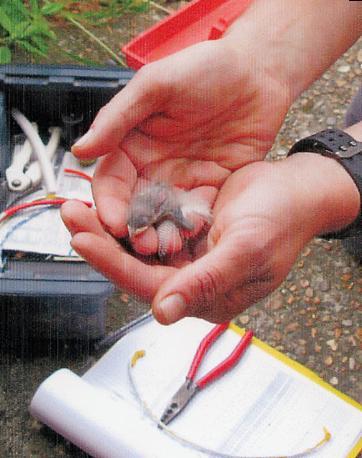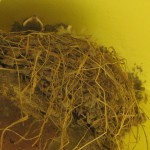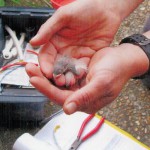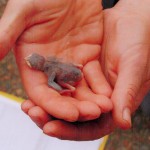By Jo’ Vincent
I have swallows nesting in my porch this year which was quite a surprise to me as usually they choose the eaves of a barn, under a bridge, or an old shed to nest. Mind you our porch is in need of a face lift but I did’nt think it was dilapidated enough for these amazing birds to choose as their Winter home but they did and have built an immaculate nest made of layers of mud, feathers, and bits of straw. I proudly showed it off to one of my friends who also has swallows nesting in her porch in Winchesea Road. She told me about David King whom I have nick-named ‘The Bird Man’. David is a local bird ringer and came out to ring the baby birds. He had to vis it s e ve r a l times to establish their progress from the stage of eggs to their birth and when they were just a few days old the fledglings were r e a d y t o be ringed.
David took them all out of the nest and placed them in a soft linen bag then put a handkerchief in the nest to prevent the mother swallow from shock should she return to an empty nest. David then took them out of the bag, one by one, placed one in his hand, and very carefully ringed them all whilst I took the photographs holding my breath as this delicate procedure progressed. Then each fledgling was gently returned to the nest. Their mother was observed perched on an electric cable cord nearby with an insect in her beak ready to feed them. In three weeks they will be ready to fly and in November they will be on their way to South Africa!
Ringing gives important information about bird life. The British Trust for Ornithology (BTO) organises the British and Irish Ringing Scheme which has been ringing birds for over ninety years. Each ring is made of a light weight metal whih is uniquely numbered and also bears an address so that anyone finding a ringed bird can help by reporting its whereabouts and fate. All the information is then entered into a computer. The BTO continue to discover new fcts about migration routes and wintering areas, the main focus of the Ringing Scheme today is the monitoring of bird populations, finding the causes of population decline, such as in the decline of Sedge Warblers breeding in Britain and Ireland was linked to lower water levels of rainfall in their African wintering quarters. Recently the dramatic decline in the numbers of Song Thrushes has been caused by a reduction in the survival rate of young birds. This information will help BOT find the environmental factors responsible for the the decline.
So please report any ringed bird that you find, however do not attempt to catch a live bird but try to read the number using binoculars or for more information about bird ringing, or int e r e s t in training to become a bird ringer writ e to, The Ringing Unit, BTO, The Nu n n e r y, The t fo r d, N o r f o l k IP24 2PU. Tel:01842 750050 Email ringi n g @ b – to.org
Rye’s Own July 2008
All articles, photographs and drawings on this web site are World Copyright Protected. No reproduction for publication without prior arrangemen




